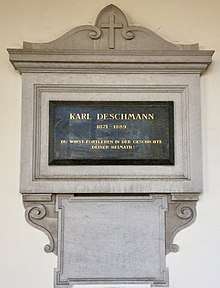Karel Dežman
Karel Dežman, also known as Dragotin Dežman and Karl Deschmann (3 January 1821 – 11 March 1889), was a Carniolan liberal politician and natural scientist. He was one of the most prominent personalities of the political, cultural, and scientific developments in the 19th-century Duchy of Carniola.[1] He is considered one of the fathers of modern archeology in what is today Slovenia.[2] He also made important contributions in botany, zoology, mineralogy, geology and mineralogy.[3] He was the first director of the Provincial Museum of Carniola, now the National Museum of Slovenia.[4] Due to his switch from Slovene liberal nationalism to Austrian centralism and pro-German cultural stances,[5] he became a symbol of national renegadism.[1]


Early life and career
He was born to an upper middle class Slovene family in Idrija, Duchy of Carniola (now in Slovenia). After his father's death in 1824, he moved to Ljubljana, where he was raised by his uncle Mihael Dežman, who was a financial supporter of the Slovene national revival, and a personal friend of the philologist Franc Metelko.
After finishing high school in Ljubljana and Salzburg in 1839, he enrolled in the University of Vienna, where he studied medicine and law. In Vienna, he soon came under the influence of Slovene romantic nationalists, and became part of the Slovene radical youth. Among others, he participated in the public funeral of the Polish exile patriot Emil Korytko in Ljubljana, and was chosen to carry his coffin.
During the Revolution of 1848, he supported the United Slovenia program, and helped organize the boycott of the elections to the Frankfurt Parliament in the Slovene Lands. In this period, he started using the name Dragotin, a Slavic version of the name Karel (Charles).
In 1849, he returned to Ljubljana. Initially, he taught at the local state secondary school. In 1852, he was appointed director of the Carniolan Provincial Museum. He continued to be active in the Slovene national movement, working with figures such as Janez Bleiweis and Franz Miklosich. Among other things, he wrote a bibliography of the poet Valentin Vodnik, and compiled the natural science terminology for Maks Pleteršnik's Slovene-German dictionary. As an author of articles supporting progressive and national liberal ideals, he influenced many young Slovene political activists, such as Fran Erjavec and Fran Levec.
Political evolution
Dežman began his political career in the Slovene National Movement, but in the mid-1850s, he became alienated from it, disenchanted with the conservatism and pragmatism of its leaders Janez Bleiweis and of Lovro Toman. Nevertheless, he was elected as a Slovene nationalist MP at the Austrian Parliament in 1861. He however did not join the Slovene national caucus, but joined the Bohemian federalists. He supported the peaceful coexistence of Slovene and German culture in the Slovene Lands. In 1862, Dežman's break with the Slovene national movement became manifest when he published a brochure entitled 'The German Culture in Carniola' (Das Deutschtum in Krain), in which he argued it is the duty of German culture to civilize and bring economic and political progress to Carniola, without Germanizing it.
Dežman himself turned to more rigid and anti-Slovene positions in the late 1860s and early 1870s, accusing the Slovene nationalists of pan-Slavism, opposing the establishing of a Slovene language university, and the equality of Slovene in public administration. Dežman's political evolution provoked fierce reactions in the Slovene public. The writer Janez Trdina compared him to Judas Iscariot.[3] The Slovene press used his name as a synonym for national renegades.[1][6]
Between 1871 and 1874, he served as mayor of Ljubljana. In 1873, he was re-elected to the Austrian Parliament on the list of the centralist liberal Austrian Constitutional Party (Verfassungspartei). After the death of Count Anton Alexander von Auersperg, Dežman became the undisputed leader of the Constitutionalist Party in Carniola, and tried unsuccessfully to prevent its demise by attempting to forge an alliance with the national progressivist Young Slovene party.
He died in Ljubljana in 1889, and was buried in St. Christopher's Cemetery in the Bežigrad district.
Scholarly achievements
Dežman was a prominent archaeologist. From 1852 till 1889, he was the curator for archeology and also the first director of the Provincial Museum of Carniola. In 1875, he started archeological excavations on the Ljubljana Marshes, which brought to the discovery of prehistorical pile dwellings at Ig. These are now protected as a UNESCO World Heritage Site. He also discovered many important Iron Age settlements in Lower Carniola.
Dežman was also interested in ethnology. In 1868, he was the first one to publish the legend of the Goldhorn, which he heard in one of his expeditions to the Julian Alps.
References
- "Archived copy". Archived from the original on 4 May 2005. Retrieved 31 May 2009.CS1 maint: archived copy as title (link)
- http://www.nms.si/slovensko/12_oddelki/arheoloski/zgodovina/zgodovina.html
- http://nl.ijs.si:8080/fedora/get/sbl:0362/VIEW/
- "Archived copy". Archived from the original on 27 July 2011. Retrieved 16 December 2010.CS1 maint: archived copy as title (link)
- Janez Cvirn, Kdor te sreča, naj te sune, če ti more, v zobe plune: Dragotin Dežman in slovenstvo In Zgodovina za vse 14/2 (2007), pp. 38–56
- http://www.livesjournal.eu/library/lives2/damgl2/stereotipi2g.htm
Sources
- Dragotin Lončar, Dragotin Dežman in slovenstvo (Ljubljana, 1930)
- Janez Cvirn, Kdor te sreča, naj te sune, če ti more, v zobe plune: Dragotin Dežman in slovenstvo In Zgodovina za vse 14/2 (2007), pp. 38–56.